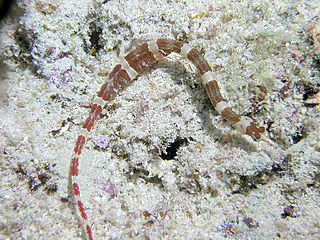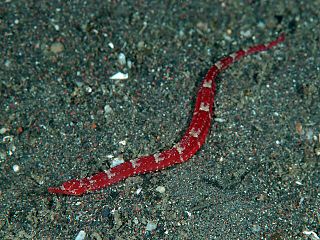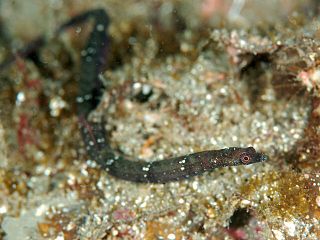
The lesser pipefish or Nilsson's pipefish is a pipefish similar to the greater pipefish, but with no crest above the head. Usually it reaches up to 17 centimetres (6.7 in) in length, maximally 18 centimetres (7.1 in), although in South Wales they are usually not more than 10 to 13 centimetres long. They have a light to dark green-brown colour with bar-like markings on the sides.

The alligator pipefish or double-ended pipefish is a species of fish in the family Syngnathidae and is the only species in the monotypic genus Syngnathoides. It is found in shallow water in the tropical and subtropical Indo-Pacific, its range extending from East Africa to northern Australia. This fish lives in habitats of seagrass and seaweed, and hides by positioning itself vertically with its head down amidst the similar-coloured fronds of vegetation. The elongated, well-camouflaged body can reach 29 cm (11 in) in length. It feeds by sucking up its prey.
Doryrhamphus janssi, commonly known as the Janss' pipefish , is a species of pipefish belonging to the family Syngnathidae.

Corythoichthys amplexus, known commonly as the brown-banded pipefish, is a species of marine fish in the family Syngnathidae.
Hippichthys cyanospilos, commonly known as the blue-spotted pipefish or bluespeckled pipefish, is a marine fish belonging to the family Syngnathidae, native from the Indo-Pacific area.

Corythoichthys flavofasciatus, known commonly as the network pipefish, reticulate pipefish and yellow-banded pipefish, is a species of marine fish in the family Syngnathidae.

Choeroichthys brachysoma is a species of marine fish of the family Syngnathidae.
Choeroichthys sculptus, the sculptured pipefish, is a species of marine fish of the family Syngnathidae.

Corythoichthys benedetto, commonly known as Benedetto's pipefish, is a species of marine fish of the family Syngnathidae. It inhabits the Indo-West Pacific, near Thailand, Myanmar, Indonesia, Papua New Guinea, and Australia. It is found on algae-covered rocky surfaces and gorgonian sea fans at depths of 5 to 20 metres, where it can grow to lengths of around 7 centimetres (2.8 in). It is usually found alone, although it can be found in groups of up to four individuals. This species is ovoviviparous, with males brooding when they are at lengths of 5 to 5.5 centimetres. The specific name and common name honour the late Italian prime minister Benedetto Craxi (1934-2000).
Dunckerocampus chapmani is a species of marine fish of the family Syngnathidae. It is endemic to New Caledonia, where it inhabits shallow lagoons to depths of 0–8 metres (0–26 ft). It has only been recorded in the vicinity of the city of Noumea. It can grow to lengths of 8.5 centimetres (3.3 in). It is expected to feed on small parasitic crustaceans that grow on other fishes, similar to most other members of its genus. This species is ovoviviparous, with males carrying eggs and giving birth to live young. The eggs of D. chapmani are particularly large, meaning that only 30 per brood are produced, which is quite low for a pipefish. Males may brood at 8 centimetres (3.1 in).

The red pipefish is a species of marine pipefish of the family Syngnathidae. It is found throughout the Indo-Pacific, from Mozambique and South Africa to Hawaii, Honshu (Japan), and New Caledonia. It lives among rubble and coral or rocky reefs at depths of 18–40 metres (59–131 ft), where they can grow to lengths of 10 centimetres (3.9 in). They are expected to feed on small crustaceans, such as gammarid shrimps, mysids, and harpacticoid copepods. This species is ovoviviparous, with males brooding eggs and giving birth to live young. Males may brood at lengths of around 5.5 centimetres (2.2 in). It is exported from Hawaii as part of the aquarium trade.
Gibbs’ pipefish is a species of marine fish of the family Syngnathidae. It is found in the Western Pacific, from the Great Barrier Reef to Palau, the Chesterfield Islands and New Caledonia. Unconfirmed specimens have been reported off of the Seychelles in the Indian Ocean. It lives in coastal sandy or rubble habitats, as well as areas with sponges and coralline algae, where it can grow to lengths of 8 centimetres (3.1 in). It is expected to feed on small crustaceans, similar to other pipefish. This species is ovoviviparous, with males brooding eggs and giving birth to live young. Males may brood at lengths of around 5 centimetres (2.0 in). The specific name honours P. E. Gibbs, who collected the type material.
The ladder pipefish is a species of marine fish of the family Syngnathidae. It is endemic to Western Australia, occurring from Shark Bay to the Monte Bello Islands. It is a habitat generalist, with species samples being taken from trawls, from among weeds and algae and one sample from a pond. It is reported to occur on rocky-reefs in inlets, bays and lagoons, as well as shallow seagrass beds. It is expected to feed on small crustaceans, and can grow to lengths of 18 centimetres (7.1 in). This species is ovoviviparous, with males brooding eggs and giving birth to live young.

Booth's pipefish is a species of marine fish of the family Syngnathidae. It is found in the Western Indian Ocean, in South Africa and the Comoro Islands, and in the Western Pacific, from South Korea and Japan to the Great Barrier Reef and Tonga. It lives in rocks and coral reefs to depths of 30 metres (98 ft), where it can grow to lengths of 17.5 centimetres (6.9 in). This species is ovoviviparous, with males carrying eggs and giving birth to live young.
Gray's pipefish, also known as the mud pipefish or spiny pipefish is a species of marine fish of the family Syngnathidae. It is found in the Indo-Pacific in the Gulf of Aden, Sri Lanka, and from the Gulf of Thailand to Japan, the Marshall Islands, and the Great Barrier Reef. It lives to depth of 100 metres (330 ft), and planktonic juveniles have been found above depths of 3,000 metres (1.9 mi). It occurs in muddy habitats, in estuaries, and on coral reefs, where it likely feeds on small crustaceans. It can grow to lengths of 20 centimetres (7.9 in). This species is ovoviviparous, with males carrying eggs in a brood pouch before giving birth to live young.

The Samoan pipefish, or brown pipefish, is a species of marine fish of the family Syngnathidae. It is found in the Indo-Pacific, from the Red Sea, to Sodwana Bay, to Taiwan, the Marshall Islands, and Samoa, where it inhabits tidepools and coral and rocky reefs to depths of 15 metres (49 ft). It is a solitary species with cryptic habits and is rarely observed. It is likely to feed on small crustaceans, and can grow to lengths of 14 centimetres (5.5 in). This species is ovoviviparous, with males carrying the fertilised eggs in a brood pouch, the folds of which fall well short of the centre of the egg-filled pouch, eventually giving birth to live young.
The spinysnout pipefish is a species of marine pipefish of the family Syngnathidae. It is found in the Indo-Pacific, from Sri Lanka to Samoa, and from Japan and the Marshall Islands to central Australia. It lives in rocky and coral reefs, rubble, lagoons and intertidal zones, often at depths of 2–12 metres (6.6–39.4 ft), where it can grow to lengths of 12 centimetres (4.7 in). It is expected to feed on small crustaceans, similar to other pipefish. This species is ovoviviparous, with males carrying eggs in a brood pouch before giving birth to live young.

Hippichthys heptagonus, the belly pipefish, is a species of freshwater pipefish of the family Syngnathidae. It is found from Kenya and South Africa to the Solomon Islands, and from southern Japan to New South Wales. It is a demersal species, living in the lower parts of rivers and streams, estuary habitats such as mangroves and tidal creeks, and occasionally in large lakes. It feeds on small crustaceans, such as copepods and cladocerans, as well as dipteran and ephemopteran larvae. It can grow to lengths of 15 centimetres (5.9 in). This species is ovoviviparous, with females depositing eggs on the males, who in turn give birth to live young several weeks later. Males may brood at 6.5–7.5 centimetres (2.6–3.0 in).
The short-keel pipefish is a species of fish of the family Syngnathidae. It is known from Darwin to the Torres Strait and southern Papua New Guinea. It lives in coastal fresh and brackish habitats, such as mudflats, mangroves, gravel, sandy and rocky habitats, and coral and shell rubble. It can grow to lengths of 12 centimetres (4.7 in). It is expected to feed on small crustaceans such as copepods, shrimps and mysids, similar to other pipefish. This species is ovoviviparous, with males carrying eggs in a brood pouch before giving birth to live young. Males may brood at 7.8 centimetres (3.1 in).

The beady pipefish is a species of pipefish of the family Syngnathidae. It is found in the Indo-West Pacific, from the western Persian Gulf, to the north central Indian Ocean, to Japan and Australia. It lives in the lower parts of streams and rivers, estuarine habitats such as seagrass beds and mangroves, and shallow inshore habitats, where it can grow to lengths of 16–18 centimetres (6.3–7.1 in). It is expected to feed on small crustaceans, similar to other pipefish. This species is ovoviviparous, with males carrying eggs in a brood pouch before giving birth to live young. Average brood size is 177.












